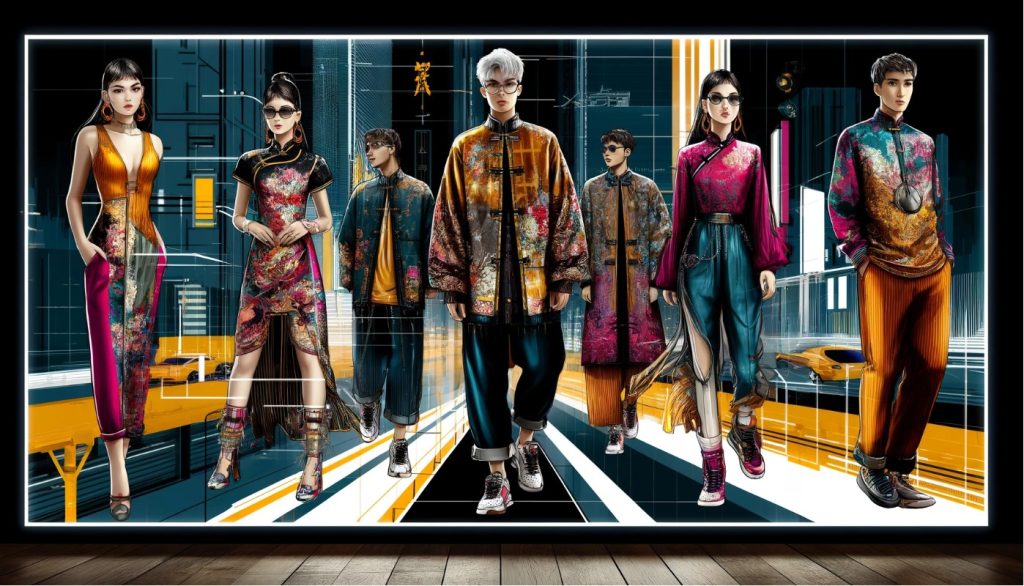Modern Chinese fashion represents a fascinating fusion of tradition and innovation. Over the past few decades, China has become an increasingly influential player in the global fashion industry. From the bustling fashion scenes of Shanghai and Beijing to the international runway shows and digital platforms, Chinese fashion is continuously evolving, shaped by rapid urbanization, globalization, and a unique cultural heritage. This dynamic evolution has led to a distinct fashion language that blends elements of Western influence with traditional Chinese aesthetics, creating a fashion culture that is both forward-thinking and deeply connected to its roots.
The modern Chinese fashion landscape is marked by the emergence of a younger, more globally aware generation of consumers, designers, and influencers. With growing disposable income, access to international trends, and a keen interest in the intersection of history and contemporary style, Chinese fashion today stands at a crossroads of modernity and tradition.
The Evolution of Fashion in China
Pre-Reform Era: Traditional Dress and Early Western Influence
Before the economic reforms of the late 20th century, Chinese fashion was primarily shaped by traditional clothing, such as the qipao and changshan for men, as well as national dress influenced by various dynasties. During the Maoist era (1949–1976), fashion was largely uniform, characterized by the Mao suit (zhongshan zhuang), which represented political and ideological conformity. The concept of fashion as an individual expression was largely suppressed during this period, as the emphasis was placed on communal values.
- Cultural Revolution and Uniformity: The Cultural Revolution (1966–1976) saw the popularization of uniform dressing, with the Mao suit becoming the standard for both men and women. This period saw little room for individual fashion or personal expression. The ideal was simplicity, modesty, and the rejection of bourgeois or Western influences.
- Early Western Influence: By the late 1970s and early 1980s, as China began to open up economically under Deng Xiaoping’s reforms, Western fashion began to penetrate urban centers. This marked the beginning of the country’s gradual transition from uniformity to a more diverse and experimental fashion landscape.
The Reform Era: A Growing Fashion Consciousness
In the 1980s and 1990s, China experienced rapid economic growth and a dramatic transformation in its fashion culture. The relaxation of government policies, urbanization, and globalization all contributed to a booming fashion market.
- Influence of Western Brands: As China opened its doors to foreign investment and began engaging with the global market, Western luxury brands such as Louis Vuitton, Gucci, and Chanel started to enter China. This influx of global brands led to the birth of consumer-driven fashion in urban areas. The 1990s saw the emergence of a fashion-conscious middle class eager to embrace Western-style clothing, consumerism, and luxury.
- The Rise of the Chinese Fashion Industry: Alongside the influx of international brands, homegrown designers and fashion brands also began to emerge. Shanghai and Beijing became central to China’s fashion scene, with the first fashion weeks taking place in these cities during the late 1990s and early 2000s.
Key Modern Chinese Fashion Trends
Youth-Driven Street Fashion
One of the most notable fashion trends in China today is the rise of street fashion, which has been heavily influenced by youth culture, K-pop, and Western pop culture. Young people, particularly in large urban centers, are adopting bold and eclectic styles that reflect their individuality and social consciousness.
- Hip-Hop and Skate Culture: With the influence of global streetwear trends, especially from the United States and Japan, Chinese youth have embraced hip-hop and skate culture. Brands such as Supreme, Bape, and Off-White have gained massive popularity in cities like Beijing, Shanghai, and Chengdu. Chinese fashion influencers and celebrities have contributed to the trend, often sporting oversized T-shirts, hoodies, sneakers, and accessories.
- Influence of K-Pop and J-Pop: The influence of K-pop (Korean pop) and J-pop (Japanese pop) on Chinese youth fashion cannot be overstated. These music and entertainment genres have introduced elements like bright colors, intricate layering, and oversized fits to the fashion landscape in China. The “idol” culture, with its focus on youthful energy and uniqueness, has further fostered the rise of street style and casual wear among young people.
Digital Fashion and Social Media Influence
China’s vast and rapidly growing digital ecosystem has reshaped how fashion is consumed and marketed. Social media platforms like WeChat, Weibo, and Douyin (the Chinese version of TikTok) have become central to how trends emerge and spread. These platforms have allowed fashion trends to gain traction in real-time, often bypassing traditional retail structures.
- Influencers and Key Opinion Leaders (KOLs): Social media influencers, or KOLs, play a significant role in shaping fashion trends. These digital celebrities often have millions of followers and are seen as the go-to sources for fashion inspiration. They collaborate with brands, provide product recommendations, and shape consumer behavior. Platforms like Weibo and Little Red Book (Xiaohongshu) have become vital tools for the fashion industry, as they facilitate direct engagement between brands and consumers.
- E-Commerce and Fast Fashion: E-commerce platforms such as Taobao and Tmall, along with fashion-focused apps like Pinduoduo, have revolutionized shopping in China. Fast fashion brands like Zara, Uniqlo, and H&M have established a strong presence in the country, tapping into the growing demand for affordable, trendy clothing. The rise of online shopping, combined with fast delivery services, has made fashion more accessible and convenient than ever before.
Sustainable Fashion and Chinese Designers
In recent years, there has been a growing movement toward sustainability in fashion. As environmental issues become more pressing, Chinese consumers and designers are increasingly turning to eco-friendly fashion solutions.
- Sustainable Materials: There is a growing demand for clothing made from organic materials, recycled fabrics, and natural dyes. Local designers have started to incorporate more sustainable practices into their collections, reducing waste and promoting ethical production. The trend is also evident in the growing interest in vintage clothing and upcycling, which is being driven by younger, more environmentally-conscious consumers.
- Homegrown Designers and Brands: The rise of Chinese designers and fashion brands is one of the most exciting aspects of modern Chinese fashion. Designers like Xander Zhou, Ding Dong, and Masha Ma are making waves internationally with collections that combine contemporary global influences with traditional Chinese elements. Many of these designers are creating pieces that celebrate both China’s cultural heritage and the country’s evolving identity as a fashion powerhouse.Shanghai Fashion Week and Beijing Fashion Week have become important events where young designers showcase their work. These platforms are helping to build a domestic fashion industry that is distinctive, innovative, and ready to compete on the global stage.
Traditional Chinese Elements in Modern Fashion
Although modern Chinese fashion is highly influenced by global trends, many designers are drawing inspiration from China’s rich cultural heritage, blending traditional elements with contemporary styles.
- The Qipao (Cheongsam): One of the most iconic garments in Chinese fashion history, the qipao has experienced a resurgence in modern times. Contemporary designers are reinventing the qipao, adapting it to modern silhouettes, fabrics, and styles. It is no longer just reserved for special occasions, but has been reimagined as an everyday fashion statement. Designers like Guo Pei have elevated the qipao to new heights, making it a symbol of luxury and high fashion.
- Chinese Embroidery and Silk: Traditional Chinese techniques, such as embroidery and the use of silk, are increasingly being incorporated into modern fashion collections. Designers often use these techniques in subtle ways, adding intricate patterns and textures to garments that combine modern cuts with ancient craftsmanship. The integration of traditional elements into contemporary fashion highlights the growing appreciation for China’s cultural heritage.
The Rise of Luxury Fashion and Consumer Culture
The emergence of a wealthy middle class in China has led to a boom in luxury fashion consumption. The demand for luxury goods has skyrocketed, with high-end brands like Louis Vuitton, Prada, and Chanel experiencing substantial growth in the Chinese market.
- Luxury Goods and Status Symbolism: In China, luxury goods are not only a sign of wealth but also a key indicator of social status. Owning high-end clothing, handbags, and accessories is seen as a way of demonstrating success and social prestige. Luxury shopping districts like Beijing’s Wangfujing and Shanghai’s Nanjing Road are popular destinations for both local and international shoppers seeking the latest designer pieces.
- Young Consumers and Aspirational Spending: The younger generation in China is driving much of the luxury goods market. With an increasing number of young people entering the workforce, many are spending a significant portion of their income on high-end fashion. The rise of digital influencers and celebrities promoting luxury brands has only amplified this trend.
Gender Fluidity and Fashion Inclusivity
China’s fashion scene is also becoming more inclusive, with a growing recognition of gender fluidity and a move away from traditional gender norms. Both Chinese consumers and designers are embracing a more inclusive approach to fashion, reflecting a broader global shift toward non-binary and gender-neutral clothing.
- Non-Binary Fashion: In recent years, Chinese designers have begun to incorporate gender-neutral elements into their collections. Designers like Haidim and Shangguan Zhe are experimenting with unisex clothing, offering garments that blur the lines between traditional masculinity and femininity. These designs challenge conventional ideas of what it means to dress as a man or a woman, and reflect the growing acceptance of diversity in fashion.
- Influence of LGBTQ+ Community: China’s LGBTQ+ community, though still marginalized in some areas, has increasingly been influencing fashion trends. The rise of LGBTQ+ celebrities and their impact on mainstream media has helped normalize gender diversity and self-expression in fashion.
The Future of Chinese Fashion
The future of Chinese fashion is poised to be exciting and transformative. As the country continues to grow economically, more consumers will have access to global fashion trends and high-end brands. At the same time, Chinese designers and brands will continue to push boundaries, blending the country’s rich cultural heritage with modern sensibilities.
- Globalization and Cultural Identity: As China becomes more integrated into the global fashion ecosystem, the challenge will be how to balance international trends with domestic cultural identity. There will be a continued emphasis on creating fashion that reflects both China’s rich history and its contemporary, modern outlook.
- Innovation and Technology: China’s fashion industry is expected to embrace technological innovations, from AI-driven fashion design to smart textiles and 3D-printed clothing. These advancements will shape the way garments are created, marketed, and consumed in the future.
China’s fashion scene is a dynamic and ever-evolving space where tradition and modernity coexist in exciting ways. With an increasing global influence, China is not only a hub for consumption but also a key player in shaping the future of the global fashion industry.







